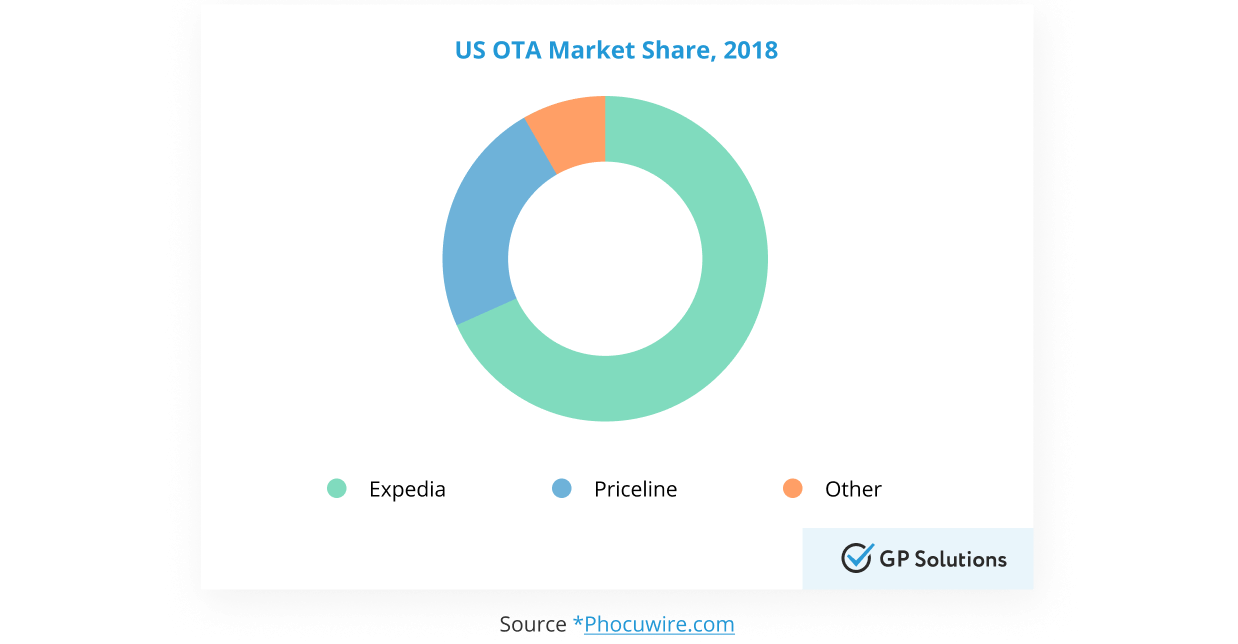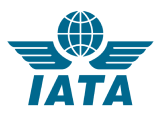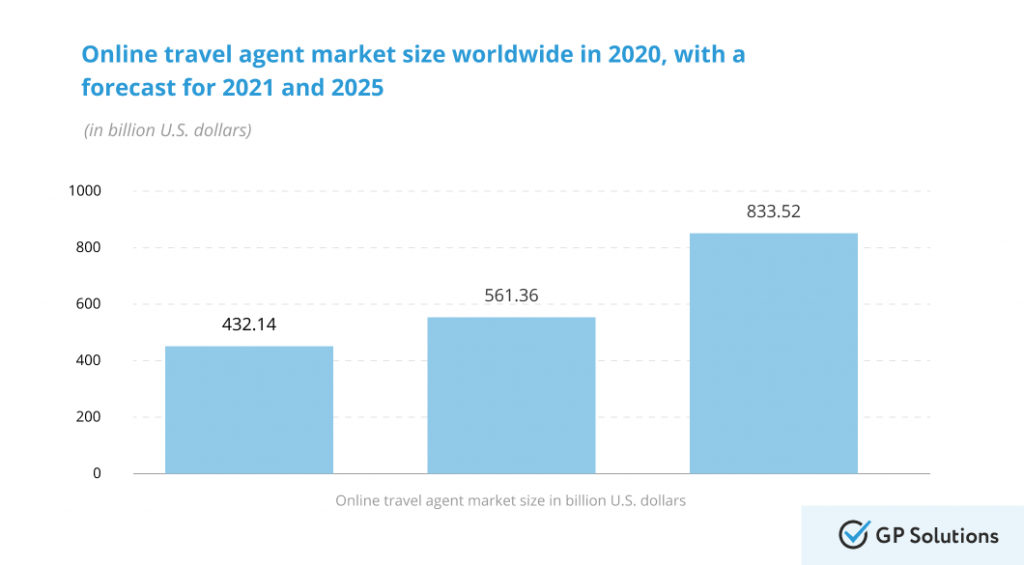
Online travel agencies (OTAs) spearhead the digital transformation in travel in recent years. They firmly occupy the majority share of the modern digital travel market (over 39 % according to Phocuswright). They’ve earned it by offering a great combination of rich travel service supply and the ‘one-stop-shop’ booking experience delivered via high-end web portals and mobile applications.
The growing demand for OTA services has naturally made this market a tempting target for aspiring entrepreneurs and startups. However, every new business has to face severe competition that first of all comes from the big brands. The likes of Booking Holdings or Expedia are dominating entire markets. For example, in the USA these two companies hold a commanding market share of 92%. Peer startups are also putting pressure, with new OTA projects popping up every day in different parts of the world. So, how does one stand out and gain ground in this very promising but equally challenging market?

Let’s try to answer this question together. In this article, we outlined the key steps one should focus on when starting a brand new OTA business. It also contains our ideas and recommendations on better ways to handle each step based on years of experience supplying technology solutions for travel startups, including new OTA businesses.

Don’t know where to start with your OTA technology? We are here to help!
Just as any journey starts with choosing your destination, a new OTA usually begins with opting the market to operate on. At this stage, it is necessary to run a careful analysis and build an all-round understanding of your market and potential clients. It is important to consider various aspects, such as:
Finding niche markets is generally a working approach with the account of its success rate and the current state of affairs in the OTA market. First of all, it offers an adequate response to the competition forced upon startups by bigger OTAs. Niche businesses can offer unique experiences that are tailored to the needs and expectations of specific limited customer groups. Secondly, it is a reasonable way to avoid overspending on marketing while securing good conversion rates thanks to more targeted outreach.
However, the mere choice of your niche can already become quite a challenge in itself. There are just so many options to consider! It makes good sense, in this case, to narrow down your list of options by leaving just the most promising at the moment and ideally in the foreseeable future. Here is a list of ‘hottest’ travel niches as of 2023 according to trustworthy travel industry sources:
COVID-19 made it clear for the whole world – remote work works! Employees are more and more inclined to escape offices and work from anywhere around the world. This trend skyrocketed during the pandemic and is not likely to fade away in the coming future. It offers amazing opportunities for creation and marketing of targeted travel products.
The social isolation enforced by governments worldwide separated family members from one another for long spans of time. Now as the borders are open, the demand for vacations involving multiple generations of the same family is quite likely to boom.
Sustainable tourism is also a steadily growing trend in travel. It focuses on travel experiences involving activities that serve various social causes. Tourists are getting increasingly more concerned about how their journeys can be beneficial to local communities in post-pandemic times.
Also known as campervan tourism, RV or mobile home travel, etc. Thousands of people will certainly explore this type of travel in 2023. A large portion of them – for the first time. It delivers a truly unique combination of travelling freedom and social distancing.
With the IT industry booming worldwide, this is an interesting niche to explore. VR technology is a great way to offer an immersive experience of vacations to remote places of the world without leaving your own country.
Accreditation is a unique number assigned to travel professionals in recognition of business trustworthiness. It is of major importance for making an OTA project successful. First of all, it permits you to book travel, receive commissions, and – with some accreditations – issue airline tickets with the most established travel suppliers. Secondly, it is a powerful tool for building trust and credibility in the travel market.

IATA identification number is worldwide recognition of your expert status in travel. It also brings lots of other benefits, such as access to the best prices from around 250 airlines and a unified interface for billing and payment transactions with suppliers.
With all the perks, no wonder it is in the highest demand and really hard to get. It normally takes months of expectation prior to getting your approval. But before that, you need to demonstrate considerable experience in travel, obtain a business license and also fulfill a set of other important criteria. All these complex requirements naturally make IATA a hard target for new businesses. But the benefits it brings definitely make it worth all the effort.

ARC is a US-only accreditation for travel agencies. Similar to IATA, it offers access to over 200 network operators and tools, as well as programs for credit card processing and anti-fraud services. There are three levels of accreditation offered by ARC for various purposes. The traditional option does not require any prior experience in this field. However, there is the ARC Specialist exam that needs to be passed by one of the employees. It increases the costs and the waiting time to get your ID.
The high filing price combined with annual fees, as well as the strict application process, including interviews with the agency owners again really can create overwhelming obstacles for new OTAs. But just like IATA it opens up great prospects and can serve as a source of trust and credibility for your business on the market.

TRUE accreditation is a great option for businesses operating in the travel agent niche. There are two levels of accreditation available: travel agency accreditation (which covers up to 5 travel agents) or host agency accreditation (accommodates up to 25 agents). It is mainly focused on the U.S. market. However, it recently shifted its focus and is now committed to operate globally.
The main advantage of TRUE number is the possibility to closely work with smaller boutique tour operators that may not be the target audience for other prominent organizations offering accreditation in travel. Also, TRUE allows agents to interact with suppliers using net rates as an alternative to more common commission-based arrangements.

This accreditation is relevant only for agencies that plan to sell cruises. As of 2022, it has been received by over 20,000 entities globally. It is the gateway to getting recognized by over 95 percent of the global cruise market. As soon as you’ve made up your mind to distribute cruise content, it is definitely worth applying for your CLIA ID.
CLIA membership requirements are not so strict. Basic membership won’t require any significant experience from you or an entrance fee (it can be required only if you go for the premium option).
It definitely is if you wish to cooperate with a GDS for flight content. Sabre or Amadeus will for sure demand an IATA ID from you. In other cases, an accreditation would still be great, but not obligatory to own.
When it comes to flights, startup OTAs often choose flight consolidators initially. These are companies like TravelFusion, Mystifly, XML.Agency, PKFARE or others. Their business is based on buying large chunks of tickets from airlines at discounted (or ‘net’) rates and then reselling them to travel agencies. The end price for the latter is good enough to apply their own markups on top and still offer tickets to travelers at prices lower than the general market. The margins that agents earn on consolidator rates are usually lower compared to what they might count on with an IATA ID. But the time-to-market is much faster and there is no need to spend heavily on getting your accreditation in place.
Joining a host agency is another working option to enter OTA business without accreditation. It means you will operate under the umbrella of a travel company that already holds its own IATA ID. This is a relatively quick and convenient way to enjoy the key benefits accreditation has to offer, such as access to GDSs and lucrative airline rates. However, you will also need to comply with a certain set of qualification requirements (they may differ depending on the host) and pay fees for the host service.
It is a common story for startup OTAs to have limited initial budgets. That is why it is crucial for them to invest carefully to make sure they get the most out of every penny. On the other hand, it is also extremely important to plan and monitor your revenues properly so you could manage and distribute available budgets with utmost productivity.
A meticulous and conscious approach at every project stage is the only way to handle this challenge successfully. With that said, there are certain aspects of business and techniques that are worth specific attention as they’ll benefit your project the most in terms of adequate budgeting.
Preparation and planning is everything. This is exactly why a properly conducted discovery phase should be an obligatory step in your startup building process. It is composed of a series of activities to build a complete project vision, define the full development scope and, most importantly, draw up a well-balanced development budget. A discovery phase will help you to develop all-encompassing project estimates by approaching your project from both the business and technical perspectives – by far the only correct way to ensure reasonable financial planning.
Discovery and Analysis Service by GP Solutions
The right way to start your travel software development

Marketing is usually the heaviest expense item that often reaches 50% of the total project cost. It is vital to spend marketing budgets wisely – in a way that would secure a solid initial base of loyal customers.
Investing your budget in merely driving the traffic to your portal from all possible sources will almost certainly lead to failure. It would be much smarter to develop a sound customer retention strategy before launching any traffic generation campaigns. Not only will this approach secure higher conversion rates, but it can also reduce marketing expenses and release extra funds to spend on better software or customer service.
For example, it is possible to achieve good results with loyalty programs based on bonus points that can partially or fully cover the cost of a travel service. This is a crucial element for smaller businesses nowadays. It is very hard to compete with larger OTAs today without it. These programs can also be extended with volume discounts (for example, “7=6” on hotels), promocode distribution campaigns, etc. All these features can get almost fully automated, which means minimum manual effort from OTA staff.
85 % of gross OTA sales derive from air tickets while hotels represent only 14 percent, says the survey performed by Hermes Management Consulting company. That said, a more detailed consideration shows that a gross margin of hotel sales is nearly twice the amount of air sales margin – 12% against 6%. So, non-air sales represent a bigger growth opportunity for OTAs.
The entire OTA business concept heavily relies on modern online technology. It takes a complex technical infrastructure to launch an OTA. First of all, there has to be a high-performing and reliable booking engine at the core that would cover your booking flows for travel products – hotels, flights, activities, car rental services or any other you might want to sell. Next, it also needs to be extended with a number of important functional blocks, such as reservation management modules, an inventory system, business rules engine for markups and commissions, a structured API for productive data exchange via the B2C or B2B channel – and many more.
But the technical platform alone, however sophisticated, is not a 100% guarantee of success. Any implementation should be based on a reasonable strategy that can pave a much safer way towards a prosperous booking portal. Here’s a few practical strategic hints that can benefit the tech side of your OTA.
This is one of the key dilemmas to go through before any implementation takes place. A bad decision here usually causes lots of trouble. There are different reasons why people choose wrong – over-focus on a particular option, bad planning, poor work on requirements… But haste is by far the most frequent reason of them all.
Take a few minutes to read this article from our blog for valuable guidelines that can help you make the right decision.
It is common practice for startups to first enter the market with a Minimum Viable Product, or MVP. It stands for a software version that offers just enough features for use by early customers who can provide valuable feedback for future product development. This technique is created to avoid excessive initial efforts. It allows to make sure that your core OTA concept really works before any full-scale development is launched.
According to Research and Markets, the mobile travel booking market is expected to grow at an average rate of 12.2% between 2021 and 2029. This is higher compared to the CAGR of 10% that is forecast for the global OTA market until 2025. Markets like North America demonstrate the share of mobile bookings as high as 40% from the overall online market, with a further growth dynamic. All these figures suggest paying specific attention to the mobile UI of your portal. It is possible to start with a mobile web version or an adaptive layout first to keep initial efforts to a minimum. Native Android and IOS apps can be released at later stages. Anyways, mobile interfaces should be kept in order at all times.

*Source: Statista 2021
No OTA website can operate as a fully closed independent system. Every modern online booking portal requires a number of integrations with external systems to perform its basic tourines – display travel product offers, process bookings, accept payments, generate performance for the management, etc.
An overwhelming majority of modern OTAs rely on 3rd-party suppliers for travel data. This group of entities combines various types of travel distribution platforms – GDSs, bedbanks, flight consolidators, other OTAs, etc. They are convenient to work with because they deliver content and confirm bookings almost fully automatically via specialized application programming interfaces (APIs). There is no need for lots of manual work as in the case with own travel inventory.
Many OTAs have turned to use travel API aggregators quite extensively in recent years. This is a great opportunity to cut down drastically on your API integration efforts by unifying multiple travel suppliers under a common product-based API. For example, a single Hotel API integration can put you through to Hotelbeds, Ratehawk, Webbeds and many other suppliers all at once in real-time. This is something really worth exploring while planning integration efforts for your OTA.
Online payment options is what really wrap up the one-stop-shop experience that is so highly valued in OTAs. The market of payment gateways is so rich that it is really easy to get lost in it. Hope these few guidelines will help narrow down your search:

Cutting-edge Booking Engine for an Ambitious Saudi Travel Startup
Check out how GP Solutions team introduced top-notch technology to automate the search&book flow built around a unique marketing idea.
Integration of a CRM system can benefit your OTA business in many ways. Systems of this type are designed to provide valuable insights into customer data, behavior and sales data. They help to determine the most promising segments of your audience and indicate opportunities to yield even better financial returns from your current customers.
Most popular CRM systems like Salesforce or Hubspot may not be the cheapest pieces of software. But if used properly they can (indirectly) save you lots of money and constantly new areas to generate extra profit.
OTAs may frequently use other systems for their day-to-day needs. These may include accounting systems, reporting and analytical tools, BI solutions, etc. A properly built export API can make the process of using them much easier, as soon as it can:
Thus, it makes sense to add this item to your OTA tech checklist.
Last but definitely not least is the level of service and experience an OTA can offer to its customers. Modern travelers are very demanding and are only willing to go for top-notch service that “flows like clockwork”. This effect can only be reached by making regular contributions into:
User interfaces. Successful online booking portals usually offer the following UI elements:
Each of these points needs constant attention and improvement in order to keep up with the market trends. Otherwise, your portal runs the risk of falling behind.
Building trust. Every visitor to your website must feel instantly at home. The credibility of this sort can be developed with the help of various activities and techniques, such as, for example:
Customer service. You can’t avoid chats in the travel industry, as users always have different inquiries and questions. Don’t forget your users have a vacation mood, so customer service should be as friendly as possible.
Online travel agencies are surely one of the pinnacles of the modern travel industry. They feed off the combination of top-notch ideas and solutions across various areas: software development, UI/UX design, online marketing, eCommerce, etc. It takes a strong background in each of these areas in order to offer competitive service for the modern market. But it is even more important to focus on the right things and make your knowledge really work to the full for the benefit of your OTA business.
Start building your online travel agency technology today!
Get in touch and learn how you can get started with us
Leave your request
We will contact you shortly
Thank you for your request!
We will get back to you as quickly as possible
Get latest insights
from our travel tech experts!
Join 200+ travel fellows! Get GP Solutions' latest articles straight to your inbox. Enter your email address below:
Thank You!